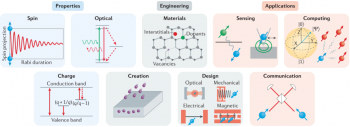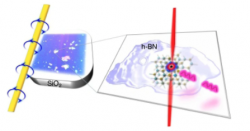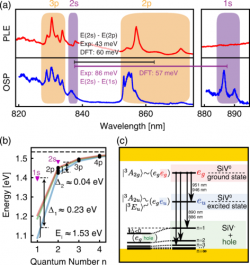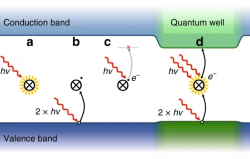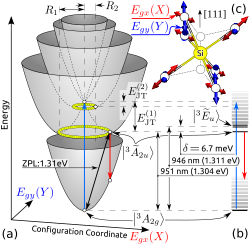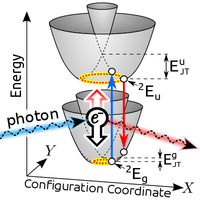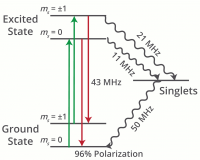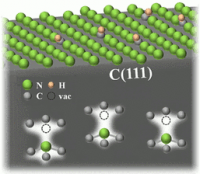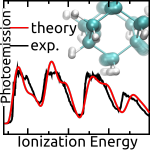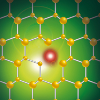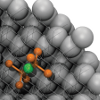Highlights history
Current main page highlights
Our group member, Anton Pershin, has been honored by receiving the János Bolyai Research Grant from the Hungarian Academy of Sciences. (2022) Congratulations!
Our group member, Gergő Thiering, has been honored by receiving the Junior Prima Prize from the Hungarian Academy of Sciences. (2022) Congratulations!
Defects with associated electron and nuclear spins in solid-state materials have a long history relevant to quantum information science that goes back to the first spin echo experiments with silicon dopants in the 1950s. Since the turn of the century, the field has rapidly spread to a vast array of defects and host crystals applicable to quantum communication, sensing and computing. From simple spin resonance to long-distance remote entanglement, the complexity of working with spin defects is fast increasing, and requires an in-depth understanding of the defects’ spin, optical, charge and material properties in this modern context. This is especially critical for discovering new relevant systems for specific quantum applications. In this Review, we expand upon all the key components of solid-state spin defects, with an emphasis on the properties of defects and of the host material, on engineering opportunities and on other pathways for improvement. This Review aims to be as defect and material agnostic as possible, with some emphasis on optical emitters, providing broad guidelines for the field of solid-state spin defects for quantum information.
Nat. Rev. Mater. pp 1-20 (2021). DOI:10.1038/s41578-021-00306-y
A plethora of single-photon emitters have been identified in the atomic layers of two-dimensional van der Waals materials. Here, we report on a set of isolated optical emitters embedded in hexagonal boron nitride that exhibit optically detected magnetic resonance. The defect spins show an isotropic ge-factor of ~2 and zero-field splitting below 10 MHz. The photokinetics of one type of defect is compatible with ground-state electron-spin paramagnetism. The narrow and inhomogeneously broadened magnetic resonance spectrum differs significantly from the known spectra of in-plane defects. We determined a hyperfine coupling of ~10 MHz. Its angular dependence indicates an unpaired, out-of-plane delocalized π-orbital electron, probably originating from substitutional impurity atoms. We extracted spin–lattice relaxation times T1 of 13–17 μs with estimated spin coherence times T2 of less than 1 μs. Our results provide further insight into the structure, composition and dynamics of single optically active spin defects in hexagonal boron nitride.
Nat. Mater. , pp. 1-6. (2021). DOI:10.1038/s41563-021-00979-4
In collaboration with the [Nathalie P. de Leon Research group] we report the realization of optically detected magnetic resonance and coherent control of SiV(0), enabled by efficient optical spin polarization via previously unreported higher-lying Rydberg-like excited states. We assign these states as bound exciton states using group theory and density functional theory. These bound exciton states enable new control schemes for SiV(0) as well as other emerging defect systems.
Phys. Rev. Lett. 125, 237402 (2021). DOI:10.1103/PhysRevLett.125.237402
In this paper, we analyze the numerical aspects of the inherent multireference density matrix renormalization group (DMRG) calculations on top of the periodic Kohn–Sham density functional theory using the complete active space approach. The potential of the framework is illustrated by studying hexagonal boron nitride nanoflakes embedding a charged single boron vacancy point defect by revealing a vertical energy spectrum with a prominent multireference character. We investigate the consistency of the DMRG energy spectrum from the perspective of sample size, basis size, and active space selection protocol. Results obtained from standard quantum chemical atom-centered basis calculations and plane-wave based counterparts show excellent agreement. Furthermore, we also discuss the spectrum of the periodic sheet which is in good agreement with extrapolated data of finite clusters. These results pave the way toward applying the DMRG method in extended correlated solid-state systems, such as point defect qubit in wide band gap semiconductors.
J. Chem. Theory Comput. 17, 2, 1143–1154 (2021). DOI:10.1021/acs.jctc.0c00809
Defect-based quantum systems in wide bandgap semiconductors are strong candidates for scalable quantum-information technologies. However, these systems are often complicated by charge-state instabilities and interference by phonons, which can diminish spin-initialization fidelities and limit room-temperature operation. Here, we identify a pathway around these drawbacks by showing that an engineered quantum well can stabilize the charge state of a qubit. Using density-functional theory and experimental synchrotron X-ray diffraction studies, we construct a model for previously unattributed point defect centers in silicon carbide as a near-stacking fault axial divacancy and show how this model explains these defects’ robustness against photoionization and room temperature stability. These results provide a materials-based solution to the optical instability of color centers in semiconductors, paving the way for the development of robust single-photon sources and spin qubits.
Nature Communications 10, 5607 (2019). DOI:10.1038/s41467-019-13495-6
The product Jahn–Teller effect may occur for such coupled electron–phonon systems in solids where single electrons occupy double degenerate orbitals. We propose that the excited state of the neutral XV split-vacancy complex in diamond, where X and V labels a group-IV impurity atom of X = Si, Ge, Sn, Pb and the vacancy, respectively, is such a system with eg and eu double degenerate orbitals and Eg quasi-localized phonons. We develop and apply ab initio theory to quantify the strength of electron–phonon coupling for neutral XV complexes in diamond, and find a significant impact on the corresponding optical properties of these centers. Our results show good agreement with recent experimental data on the prospective SiV(0) quantum bit, and reveals the complex nature of the excited states of neutral XV color centers in diamond.
npj Comput Mater 5, 18 (2019). DOI:10.1038/s41467-019-13495-6
We use density-functional theory calculations to see if other group-IV elements—namely, germanium, tin, and lead—in a vacancy center exhibit similar optical properties to silicon but with improved spin properties that permit an economical cooling system. We develop a new theory for understanding the interaction of light and magnetic fields with these color centers, and we explore how the dynamical motion of the atoms strongly affects the magneto-optical properties of the color center. By combining our theory with density-functional theory calculations, we find that lead-vacancy color centers should have favorable optical and spin properties for operating at room temperature.
Phys. Rev. X 8, 021063 (2018). DOI:10.1103/PhysRevX.8.021063
Our ab initio simulations determined the magneto-optical properties of the neutral divacancy in silicon carbide that contributed to understanding its qubit operation carried out by Prof. David D. Awschalom group.
Phys. Rev. X 7, 021046 (2017). DOI:10.1103/PhysRevX.7.021046
Our ab initio study identified the nitrogen terminated (111) diamond surface to host shallow nitrogen-vacancy centers for quantum sensing. In cooperation with Alex Retzker we showed, that special quantum simulations can be carried out with the nitrogen nuclear spins in this system
Nano Letters 17 (4), pp 2294-2298. (2017) DOI:10.1021/acs.nanolett.6b05023
We investigated the electron-phonon coupling in small diamond cages called diamondoids. These quantum systems are mostly modelled within the Born-Oppenheimer approximations, where the coupling between the electrons and vibration modes is not fully taken into account. In our study we shown that the severe electron-phonon coupling is a key point to properly describe the overall lineshape of the experimental photoemission spectrum. Our method goes beyond the typical Born-Oppenheimer approximation, where the electrons are pure electron-like quasi-particles. In our model, we deduced a link between the many-body perturbation approach of the electron-phonon coupling and the well-known Jahn-Teller effect.
Nature Communications 7: 11327. (2016). DOI:10.1038/ncomms11327
Older items
In an international cooperation with Japanese and Australian colleagues, we supported the establishment and identification of the carbon antisite–vacancy pair as a new kind of single-photon emitter in silicon carbide with theoretical work and computational simulation. The results have been highlighted in Nature Physics and Nature Photonics.
Nature Materials 13 151-156 (2014) DOI:10.1038/nmat3806
In a cooperation with partners in Russia and Germany, we have taken part in the work of predicting and validating the properties of silicon-vacancy colour centres in nanosized diamond particles. We have contributed with time-dependent DFT calculations, not carried out on such large systems so far. Nanoparticles for validating experiments have been extracted from a meteorite sample, but production of similar artificial nanoparticles seems to be very prospective in e.g. biosensing. This article has been selected for review in Nature News and Views.
Nature Nanotechnology 9, 54–58 (2014) DOI:10.1038/NNANO.2013.255
